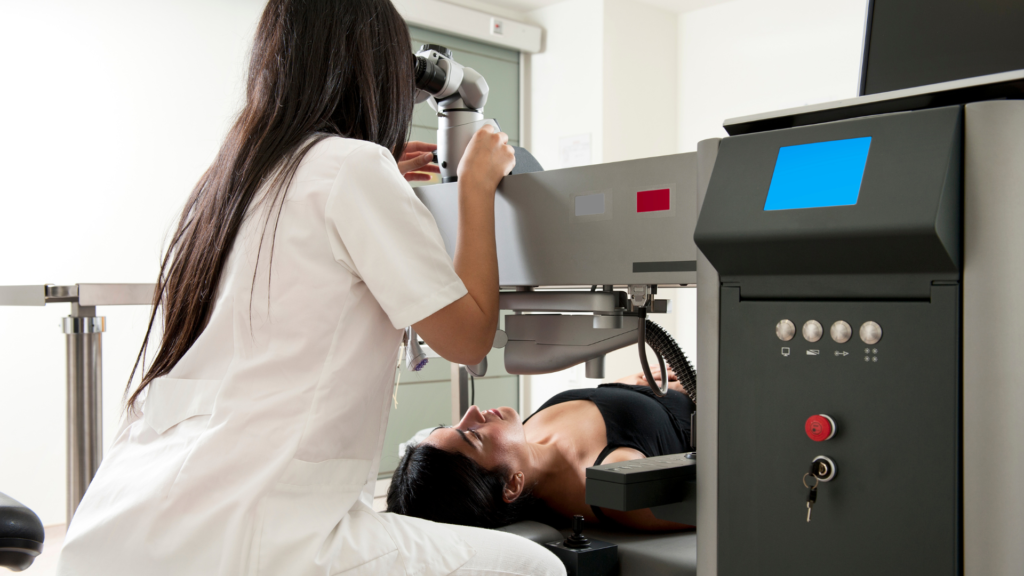Laser eye surgery is a surgical procedure that corrects vision errors, like near-sightedness, far-sightedness, and astigmatism. The surgery uses a laser to reshape the cornea, which is the clear tissue at the front part of the eye. The laser triggers a reaction in the tissue, causing it to change shape. The cornea is designed to bend the light that comes into it so it has a clear, natural focal point. The laser reshapes the cornea so that light passes through it and focuses on the retina in the back of the eye.
Laser eye surgery is an appealing option for patients who don’t want to wear glasses or contact lenses. It permanently corrects vision flaws like near-sightedness, farsightedness, astigmatism, and presbyopia. But how does laser eye surgery work? In short, it uses a laser to remove a small layer of tissue from the cornea, the clear dome-shaped window at the front of the eye. It is a procedure that corrects vision problems by reshaping the cornea with lasers. The cornea is the transparent front part of the eye and is what lets light enter the eye. Vision problems can be caused by many different things, including the cornea being too thick or too thin. This can happen naturally or be caused by an injury. Light cannot properly focus on the eye when the cornea is too thin, resulting in blurry vision. Light focuses in front of the retina when the cornea is too thick, resulting in blurry vision.
LASIK (Laser-Assisted in Situ Keratomileusis)
LASIK, or laser-assisted in situ keratomileusis, is one of the world’s most popular and successful elective surgeries. It is a procedure where surgeons use lasers to reshape your corneas, or the front surface of your eye, to correct your vision. Many people choose this procedure because of how quick it is—it only takes a few minutes for the procedure. And patients notice results immediately following the procedure, too.
LASIK surgery is typically an outpatient procedure. It involves making a small cut on the patient’s cornea. A small flap of tissue will then be created, and a laser will be used to make the cut. The surgeon will then apply a protective bandage and use drops to keep the cornea moist. Usually, patients can resume normal daily activities within a few days.
PRK (PhotoRefractive Keratectomy)
Photorefractive Keratectomy (PRK), photorefractive amblyopia control, and amblyopia correction is a type of laser eye surgery to correct near-sightedness and far-sightedness (myopia and hyperopia). Refractive surgery works by reshaping the cornea to correct the refractive error. In PRK, the doctor removes the outer layers of the cornea, leaving the underlying corneal tissue intact. This removed tissue is then reshaped to create a refractive correction.
PRK is an alternative to traditional LASIK surgery for correcting myopia or near-sightedness. Instead of creating a corneal flap, it removes small areas of tissue from the front of the cornea and replaces them with an intraocular lens. The procedure is performed by making small incisions in the cornea and removing the tissue with an instrument known as a microkeratome.
LASEK (Laser Epithelial Keratomileusis)
Keratomileusis, also known as LASEK, is a surgical procedure that changes the shape of the cornea, the clear tissue that covers the front of the eye. By reshaping the cornea, keratomileusis helps correct near-sightedness, far-sightedness, and astigmatism. LASEK is similar to LASIK, but instead of using a laser, it uses a microkeratome. The microkeratome is a bit like a cookie-cutter, but it is shaped in a way that fits all sizes of corneas.
Laser epithelial keratomileusis has been a popular alternative to LASIK for years. Like LASIK, LASEK reshapes the cornea to allow more light into your eyes. However, LASEK differs in that it doesn’t require an incision; rather, it uses a blade to shave away the top layer of the cornea. During LASIK, an incision is made in the cornea, and the laser reshapes the tissue. LASEK is easier to perform and may be a good option for people who don’t like the look of a LASIK flap or who can’t have LASIK because their cornea is too steep.
